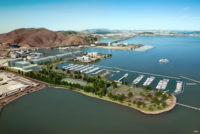The Marin Municipal Water District (MMWD) is moving forward with a plan to pipe water across San Francisco Bay to make up for harsh drought conditions in its region. The proposed five to six-mile-long pipeline would run across the Richmond-San Rafael Bridge, carrying 10 to 15 million gallons of water a day, which the district says would help refill reservoirs that supply about 75% of its water.
The district plans to purchase water from Central Valley for $10 million to $18 million and have it supplied through the East Bay Municipal Utility District, which neighbors MMWD to the east. “We would procure the water and get it to EBMUD for treatment and it would send water over to us to match what we purchase from the Central Valley,” says Larry Russell, vice president of Marin Water's board of directors. “The idea is to offset the lack of rain that has occurred in our watershed.”
Engineer WSP Global is the main evaluator and designer for the proposed project and Caltrans owns the 5.5-mile-long bridge that will carry the pipe. WSP’s first report will come out at the end of August and cover design alternatives for board review. The board will verify feasibility and seek California Environmental Quality Act approvals.
The cost of building the pipeline and associated infrastructure is estimated to be between $50 million and $70 million, but that figure can change depending on where exactly Caltrans wants the pipe attached to the double-deck bridge, says Russell. Overall, he says preliminary design of the project is about 20% complete, with construction expected to break ground in February 2022 and finish in June.
The Marin district, which serves more than 191,000 people in the county's central and southern area, had explored renting two massive desalination units to help offset the rain shortage, but decided against that option, based on an estimated $30 million cost and that it would only bring in only about half of the needed water if the drought continues.
MMWD's seven reservoirs in the Mount Tamalpais watershed that provide about 75% of its water supply are currently at about 40% capacity following two years of low rainfall. The remaining supply comes from neighboring Sonoma County’s Russian River water system.
Russell says the pipeline will be roughly 24 in. in diameter and be either mortar lined and coated, or high-density polyethylene to hold up against impacts of the salty Bay Area climate. Two pump stations would also be built on the east and west side of the bridge to keep water flowing.
The biggest challenge for district planners is moving the project forward with rainfall uncertainties for next year. “I hope it rains like cats and dogs in the fall and we don’t need this project at all - even if we’ve already built it,” Russell says. “But it is still important to have in emergencies such as earthquakes because it provides important connections to other water districts.”





Post a comment to this article
Report Abusive Comment